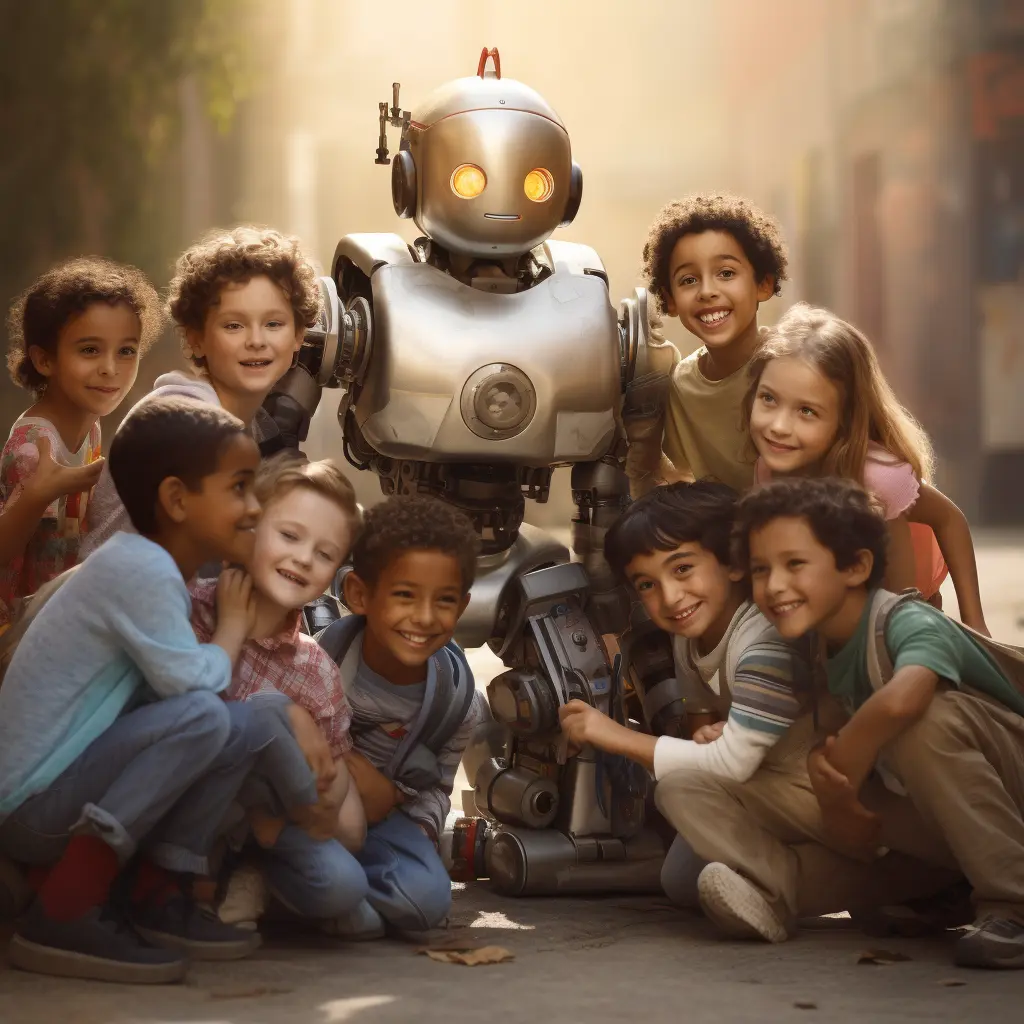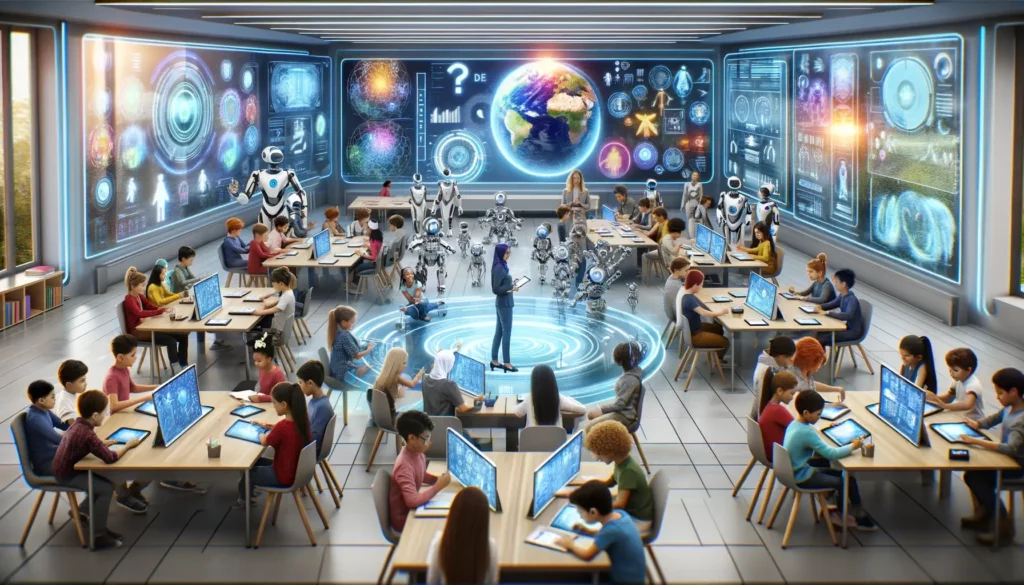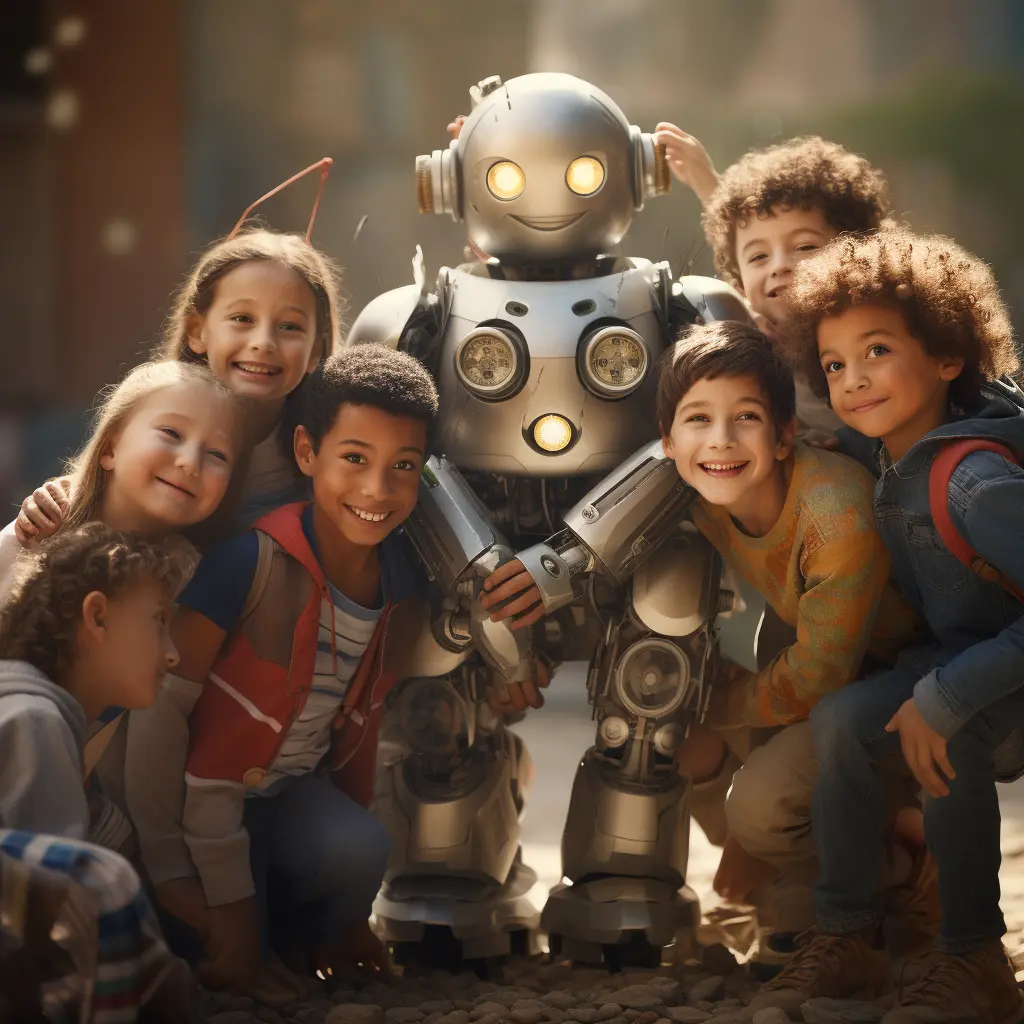In today’s rapidly evolving tech landscape, the educational sector is experiencing a transformative shift. Emerging technologies are reshaping learning environments, making education more dynamic, accessible, and personalized. Among these, Artificial Intelligence (AI) in education stands as a beacon of change. Let’s delve into how AI and other innovative technologies are revolutionizing learning experiences.
AI in Education: A New Paradigm
Personalising Learning Experiences AI’s ability to tailor learning to individual and group needs is its most significant contribution. Analyzing data on students’ learning habits, AI creates adaptive learning paths, catering to various learning styles and speeds. This personalisation not only enhances understanding but also boosts student engagement and motivation.
AI-Powered Educational Assistants The emergence of AI tutors and assistants offers round-the-clock educational support. These systems provide instant answers, detailed explanations, and additional learning resources, making education a continuous, accessible journey.
Transforming Education with Adaptive Learning Algorithms AI’s adaptive learning algorithms are revolutionizing education. By identifying students’ strengths and weaknesses, AI customises the curriculum to challenge each learner at their level, making education more effective and rewarding.
Automating Administrative Tasks with AI AI is streamlining administrative duties in educational settings, from grading assignments to managing schedules. This efficiency transforms the backend of education, allowing educators to focus more on teaching.
AI Chatbots for Continuous Engagement: AI Chatbots serve as an always-available point of contact for parents and students. These tools provide immediate, personalised responses to queries, ensuring that parents and students have access to custom information whenever needed.
AI in education is more than just a technological addition; it represents a fundamental shift in how we teach and learn. With AI, education becomes more accessible, efficient, and tailored to individual needs, opening a new chapter in educational excellence. Discover more about how AI is integrated into our services on our AI-Infused Services page.
E-Learning: The Digital Classroom Evolution
Redefining Accessibility and Flexibility in Learning The rise of e-learning has marked a significant milestone in the history of education. This digital revolution has redefined what it means to learn, breaking down geographical barriers and offering unprecedented access to knowledge.
- Global Classroom: E-learning platforms have turned the world into a global classroom. Learners from different corners of the globe can now access the same quality of education, removing physical and socio-economic barriers.
- Flexibility and Convenience: With e-learning, the constraints of time and place are a thing of the past. Students can learn at their own pace, fitting education into their personal schedules, which is particularly beneficial for adult learners and professionals.
Customized Learning Experiences One of the most significant advantages of e-learning is the ability to customize learning experiences. Interactive courses, multimedia content, and adaptive learning systems ensure that the educational journey is tailored to individual learner needs.
- Interactive and Engaging: E-learning isn’t just about reading and watching. It’s an interactive experience that includes quizzes, discussions, and practical tasks, making learning more engaging and effective.
- Adaptive Systems: Many e-learning platforms now use AI to adapt the content based on the learner’s progress, ensuring that each student receives a personalized learning experience.
Challenges and Future Directions While e-learning has opened up new horizons, it also comes with its set of challenges. Ensuring consistent access to technology, addressing the digital divide, and maintaining student engagement in a virtual environment are ongoing concerns.
- Bridging the Digital Divide: As we move forward, it’s crucial to address the disparities in access to digital tools and internet connectivity.
- Innovative Engagement Strategies: The future of e-learning lies in finding innovative ways to keep learners engaged and motivated in a virtual setting.
E-learning has transformed the educational landscape, offering flexibility, accessibility, and personalized learning opportunities. As we navigate this digital era, the continuous evolution of e-learning platforms will play a pivotal role in shaping the future of education.

Big Data & Analytics in Learning
Unlocking Insights in Education The integration of Big Data and analytics in education is revolutionizing how educational institutions understand and enhance learning. By collecting and analyzing vast amounts of data, educators and administrators can make more informed decisions that directly impact student learning outcomes.
- Tracking Student Performance: Big Data tools enable the tracking of individual student performance over time. This data can reveal patterns in learning, highlighting areas where students excel or struggle.
- Informing Teaching Strategies: Analytics provide valuable insights into the effectiveness of teaching methods. By understanding what works and what doesn’t, educators can refine their approaches to meet the diverse needs of their students.
Personalized Learning Pathways Analytics play a crucial role in developing personalized learning pathways. By analyzing student data, educational tools can adapt the curriculum to suit individual learning styles and paces.
- Adaptive Learning Technologies: These technologies use analytics to adjust the difficulty level of tasks and the types of resources offered to students, ensuring a tailored educational experience.
- Predictive Analytics: Predictive models can forecast potential learning outcomes, helping educators intervene early and provide additional support where needed.
Ethical Considerations and Challenges While Big Data and analytics offer significant benefits, they also raise important ethical considerations around privacy and data security. It is essential to handle student data responsibly and transparently.
- Data Privacy: Ensuring the confidentiality and security of student data is paramount. Educational institutions must adhere to strict data protection regulations.
- Avoiding Bias: There is also a need to be vigilant about potential biases in data collection and analysis, ensuring that the insights gained do not inadvertently disadvantage certain groups of students.
Big Data and analytics are powerful tools in the realm of education, offering deeper insights into student learning and enabling more effective and personalized educational experiences. As we embrace these technologies, it is equally important to address the ethical challenges they present, ensuring a fair and secure educational environment for all.
Cloud Computing: Accessible Educational Resources
The Cloud: A Game-Changer in Education Cloud computing has emerged as a game-changer in the field of education, offering scalable and cost-effective resources that enhance learning experiences. It represents a shift towards more accessible, collaborative, and efficient educational models.
- Accessibility and Flexibility: Cloud-based platforms and resources are accessible anytime, anywhere, enabling learners and educators to access materials and collaborate regardless of their physical location.
- Resource Scalability: Cloud computing allows educational institutions to scale resources up or down based on demand, making it an efficient solution for managing digital educational content.
Enhancing Collaboration and Engagement The cloud facilitates a collaborative learning environment where students and teachers can easily share resources and work together on projects in real-time.
- Real-time Collaboration: Tools like online document editors and virtual whiteboards enable real-time collaboration, making group projects and remote learning more interactive and productive.
- Engagement Through Interactive Tools: Cloud-based educational tools often come with interactive features that enhance student engagement, such as discussion forums, polls, and quizzes.
Cost-Effectiveness and Sustainability Cloud computing not only reduces the need for physical infrastructure and maintenance but also contributes to sustainability in education.
- Reduced Infrastructure Costs: With cloud computing, the need for expensive hardware and software is significantly reduced, making it a cost-effective solution for schools and colleges.
- Sustainable Education Model: By minimizing physical resource requirements, cloud computing supports eco-friendly practices in education.
Cloud computing is transforming the educational sector by making learning resources more accessible, enhancing collaboration, and offering a sustainable, cost-effective solution. Its continued integration into educational systems promises to further democratize and enhance the learning experience.
Immersive Learning with VR and AR
Bringing Education to Life with Virtual and Augmented Reality Immersive learning, through the use of Virtual Reality (VR) and Augmented Reality (AR), is transforming the educational landscape by offering experiential and engaging learning experiences.
- Virtual Reality in Classrooms: VR immerses students in a fully virtual environment, perfect for simulations and experiencing scenarios that are impossible or impractical in the real world. From historical reenactments to scientific explorations, VR brings subjects to life.
- Augmented Reality for Enhanced Learning: AR overlays digital information onto the real world, enhancing the learning experience with interactive elements. It’s particularly effective in subjects like anatomy, architecture, and engineering, where visualizing concepts in 3D adds significant value.
Benefits of Immersive Learning Experiences Immersive technologies offer unique benefits in education, making complex subjects more accessible and engaging for students.
- Enhanced Engagement and Retention: The interactive nature of VR and AR leads to higher engagement levels and better retention of information, as students are active participants in their learning process.
- Safe Learning Environments: These technologies provide a safe space for students to experiment and learn from their mistakes without real-world risks or consequences.
The Future of Immersive Education As VR and AR technologies continue to evolve, their potential in education is boundless. They offer opportunities for more personalized and inclusive learning experiences.
- Personalization and Accessibility: Future developments in immersive learning could lead to more personalized educational experiences, catering to different learning styles and needs.
- Inclusivity in Learning: With the potential to simulate various environments and scenarios, VR and AR can make education more inclusive, providing experiences that were once out of reach for many students.
Immersive learning through VR and AR is not just a technological advancement; it’s a paradigm shift in how we approach education. These technologies are creating new, exciting ways to learn, making education more interactive, engaging, and inclusive.
Gamified Learning: Making Education Fun
Transforming Education with Game Elements Gamified learning, the integration of game elements into educational settings is revolutionizing how students engage with their studies. This approach makes learning more interactive and enjoyable, significantly enhancing student motivation and engagement.
- Incorporating Game Mechanics: Elements such as points, badges, leaderboards, and challenges are used to gamify learning experiences. These features add a competitive and fun aspect to education, motivating students to engage more deeply with the material.
- Enhancing Motivation and Participation: Gamification increases motivation by offering rewards and recognition for achievements. This approach encourages continued participation and effort, making learning more appealing.
Benefits of Gamified Learning The gamification of education offers several key benefits, making it a powerful tool in modern educational strategies.
- Improved Engagement and Retention: The interactive nature of gamified learning leads to higher engagement levels and better retention of information, as it transforms learning into a more active and enjoyable process.
- Developing Soft Skills: Besides academic knowledge, gamified learning helps in developing important soft skills like problem-solving, critical thinking, and teamwork.
Challenges and Considerations While gamified learning offers numerous advantages, it’s essential to balance game elements with educational content and consider diverse learning preferences.
- Balancing Fun and Learning: The challenge lies in ensuring that the game elements enhance learning without overshadowing the educational objectives.
- Catering to Diverse Learners: It’s important to design gamified experiences that cater to a range of learning styles, ensuring that all students benefit from this approach.
Gamified learning is a dynamic and innovative way to make education more engaging and enjoyable. By incorporating game elements into learning, educators can create an environment where students are motivated to learn and participate, leading to improved educational outcomes and the development of essential life skills.

Blockchain’s Role in Education
Securing and Streamlining Educational Processes Blockchain technology, best known for its use in cryptocurrencies, is finding innovative applications in the education sector. Its key features, like security, transparency, and decentralization, offer unique benefits to educational processes.
- Secure Record Keeping: Blockchain provides a secure and unchangeable record of student achievements, from grades to certifications. This technology ensures the authenticity and permanence of academic records, making them easily verifiable and transferable.
- Credential Verification: With blockchain, educational institutions can issue tamper-proof credentials, simplifying the verification process for employers and other educational institutions.
Enhancing Transparency and Trust Blockchain’s transparent nature fosters trust in educational transactions and records. It offers a clear, auditable trail of academic credentials and achievements.
- Decentralized Access to Records: Students can have direct access to their educational records, empowering them to manage and share their academic achievements.
- Streamlining Administrative Processes: Blockchain can streamline various administrative processes in education, reducing costs and increasing efficiency.
Challenges and Future Potential While blockchain in education presents exciting opportunities, it also faces challenges, particularly in terms of widespread adoption and understanding.
- Overcoming Technological Barriers: The integration of blockchain technology requires overcoming certain technological and infrastructural barriers.
- Educational Outreach and Understanding: There is a need for greater awareness and understanding of blockchain technology among educators and administrators for its effective implementation.
Blockchain technology holds significant potential for transforming educational processes, offering secure, transparent, and efficient ways to manage academic records and credentials. As the technology matures and becomes more accessible, its role in education is likely to expand, paving the way for more streamlined and trustworthy educational systems.
IoT (Internet of Things): Smart Learning Environments
Integrating IoT into Educational Settings The Internet of Things (IoT) is making significant inroads in education, creating smart learning environments that enhance educational experiences. IoT involves the interconnection of physical devices, like sensors and smart devices, providing real-time data and interactive experiences.
- Interactive Classrooms: IoT devices can transform classrooms into interactive learning spaces. Smartboards, automated attendance systems, and real-time feedback tools are just a few examples of how IoT enhances the learning environment.
- Efficient Management of Educational Facilities: IoT can also be used for efficient campus management, such as monitoring resource usage and maintaining optimal learning conditions.
Benefits of IoT in Education The implementation of IoT in educational settings offers several advantages, from personalized learning experiences to enhanced operational efficiency.
- Personalized and Engaging Learning: IoT devices can tailor educational content to individual students’ needs and provide engaging, interactive learning experiences.
- Data-Driven Insights: The data collected from IoT devices can provide valuable insights into student engagement and facility usage, aiding in decision-making and optimization of resources.
Challenges and Future Prospects While IoT presents exciting opportunities, it also comes with challenges, including security concerns and the need for infrastructure.
- Security and Privacy Concerns: The increased use of IoT devices raises concerns about data security and student privacy. Ensuring robust security measures is crucial.
- Infrastructure and Connectivity Requirements: Implementing IoT solutions requires adequate infrastructure and connectivity, which can be a challenge in some educational settings.
IoT is poised to revolutionize the educational landscape, offering smarter, more interactive, and efficient learning environments. As the technology evolves and becomes more accessible, IoT’s role in education is expected to grow, leading to more innovative and effective educational practices.
Conclusion: Embracing the Future of Education
As we’ve explored the top ten technological innovations in education, it’s clear that we are on the cusp of a new era in teaching and learning. From AI-driven personalized learning experiences to IoT-enabled smart classrooms, technology is reshaping the educational landscape in profound ways.
- A Future of Inclusivity and Accessibility: These technological advances promise a future where education is more inclusive, accessible, and tailored to individual needs and learning styles.
- Continuous Evolution and Adaptation: As technology continues to evolve, so will educational methods and tools, offering ever more innovative ways to engage, inspire, and educate learners of all ages.
The Role of Educators and Institutions In this rapidly changing environment, the role of educators and educational institutions is more important than ever. Embracing these technologies, understanding their potential, and integrating them into educational curricula will be key to unlocking their full benefits.
- Lifelong Learning and Adaptation: Educators must become lifelong learners themselves, continually adapting to these new tools and techniques.
- Ethical Considerations: As we integrate these technologies, we must also be mindful of ethical considerations, ensuring that we prioritize student privacy, data security, and equitable access.
We invite educators, administrators, students, and all stakeholders in the education sector to join us in embracing these technological innovations. Together, we can create a future of education that is more effective, engaging, and equitable for everyone.
As we navigate this exciting and ever-changing landscape, we look forward to the endless possibilities that these technologies bring to the world of education.
ChatGPT Notes:
In crafting this insightful blog post, I teamed up with Manolo to explore the cutting-edge world of education technology. Our collaboration was a blend of Manolo’s vision and my AI-driven writing capabilities.
- Manolo steered the process with his insights and directives:
- He chose the blog post’s theme, focusing on the latest trends in educational technology.
- Provided detailed input, ensuring the content aligned with his blog’s ethos.
- Gave feedback on the blog post’s structure and content, leading to several rounds of revisions for clarity and impact.
- Emphasized the importance of including a section on AI Chatbots, enhancing the article’s relevance and depth.
Throughout our collaboration, we iteratively refined the content, ensuring it resonated with Manolo’s audience and encapsulated his unique perspective. Additionally, to visually complement the post, Manolo utilized a tool like MidJourney and DALL-E for image generation, adding a creative touch to the narrative. This post is a testament to the synergy of human creativity and AI, embodying the spirit of Manolo’s blog.
